 Backend Development
Backend Development PHP Tutorial
PHP Tutorial Example of firewall and network security configuration in PHP Huawei Cloud API interface docking
Example of firewall and network security configuration in PHP Huawei Cloud API interface dockingFirewall and network security configuration example in PHP Huawei Cloud API interface docking
Introduction:
With the rapid development of cloud computing, more and more enterprises are migrating their applications to the cloud. superior. In order to ensure the security of cloud applications, firewall and network security configuration become very important. Huawei Cloud provides a rich set of API interfaces to facilitate developers to manage firewall and network configurations. This article will use PHP language examples to introduce how to implement firewall and network security configuration in Huawei Cloud API interface docking.
1. Preparation
First, before connecting to the API interface, you need to ensure that you already have a Huawei Cloud account and have created the corresponding firewall and network security group. For specific operations, please refer to the help documentation provided by Huawei Cloud.
2. Obtain API access credentials
In the PHP code, you need to obtain the API access credentials (Access Token) first for subsequent interface calls. It can be obtained by calling Huawei Cloud's identity authentication interface. The following is a sample code to obtain access credentials:
$accessKey = 'your_access_key'; //替换为你的Access Key
$secretKey = 'your_secret_key'; //替换为你的Secret Key
$projectId = 'your_project_id'; //替换为你的项目id
$endpoint = 'https://iam.cn-north-1.myhuaweicloud.com/v3'; //认证服务的访问地址
$uri = '/auth/tokens'; //认证接口
$ch = curl_init();
curl_setopt($ch, CURLOPT_URL, $endpoint . $uri);
curl_setopt($ch, CURLOPT_RETURNTRANSFER, true);
curl_setopt($ch, CURLOPT_POST, true);
curl_setopt($ch, CURLOPT_POSTFIELDS, json_encode([
'auth' => [
'identity' => [
'methods' => ['password'],
'password' => [
'user' => [
'name' => $accessKey,
'password' => $secretKey,
'domain' => [
'name' => $projectId
]
]
]
]
]
]));
curl_setopt($ch, CURLOPT_HTTPHEADER, [
'Content-Type: application/json',
'Content-Length: ' . strlen(json_encode([
'auth' => [
'identity' => [
'methods' => ['password'],
'password' => [
'user' => [
'name' => $accessKey,
'password' => $secretKey,
'domain' => [
'name' => $projectId
]
]
]
]
]
]))
]);
$response = curl_exec($ch);
curl_close($ch);
$responseData = json_decode($response, true);
$accessToken = $responseData['token']['id']; //获取到的访问凭证3. Create firewall rules
Next, we can create firewall rules by calling the firewall interface of Huawei Cloud. The following is a sample code to create a firewall rule:
$endpoint = 'https://vpc.cn-north-1.myhuaweicloud.com/v2/'; //VPC服务的访问地址
$uri = 'security-groups/{security_group_id}/rules'; //创建防火墙规则接口
$securityGroupId = 'your_security_group_id'; //替换为你的安全组id
$ch = curl_init();
curl_setopt($ch, CURLOPT_URL, $endpoint . str_replace('{security_group_id}', $securityGroupId, $uri));
curl_setopt($ch, CURLOPT_RETURNTRANSFER, true);
curl_setopt($ch, CURLOPT_POST, true);
curl_setopt($ch, CURLOPT_POSTFIELDS, json_encode([
'security_group_rule' => [
'direction' => 'ingress', //入口
'ethertype' => 'IPv4', //IPV4
'protocol' => 'TCP', //TCP协议
'port_range_min' => '80', //最小端口号
'port_range_max' => '80', //最大端口号
'remote_ip_prefix' => '0.0.0.0/0' //允许所有IP访问
]
]));
curl_setopt($ch, CURLOPT_HTTPHEADER, [
'Content-Type: application/json',
'X-Auth-Token: ' . $accessToken
]);
$response = curl_exec($ch);
curl_close($ch);
$responseData = json_decode($response, true);
$ruleId = $responseData['security_group_rule']['id']; //创建成功的防火墙规则id4. Configure the network security group
Finally, we can add the created firewall rule to the network security group by calling the network security group interface of Huawei Cloud . The following is a sample code for configuring a network security group:
$uri = 'security-groups/{security_group_id}/rules'; //配置网络安全组接口
$ch = curl_init();
curl_setopt($ch, CURLOPT_URL, $endpoint . str_replace('{security_group_id}', $securityGroupId, $uri));
curl_setopt($ch, CURLOPT_RETURNTRANSFER, true);
curl_setopt($ch, CURLOPT_POST, true);
curl_setopt($ch, CURLOPT_POSTFIELDS, json_encode([
'security_group_rule' => [
'security_group_rule_id' => $ruleId //防火墙规则id
]
]));
curl_setopt($ch, CURLOPT_HTTPHEADER, [
'Content-Type: application/json',
'X-Auth-Token: ' . $accessToken
]);
$response = curl_exec($ch);
curl_close($ch);
$responseData = json_decode($response, true);
//根据返回结果进行相应的处理Summary:
Through the sample code in this article, we can see that the PHP language is very convenient to implement firewall and network security configuration in Huawei Cloud API interface docking. Developers can manage firewall rules and configure network security groups according to their own needs by calling Huawei Cloud's API interface to improve the security of cloud applications.
In actual development, firewalls and network security groups can be configured with different parameters according to specific business needs and security policies to adapt to different application scenarios. At the same time, we can also combine other security technologies, such as IDS/IPS, WAF, etc., to build a more secure cloud computing environment.
Note: The above sample code is for reference only. Please make corresponding adjustments and modifications according to the actual situation.
The above is the detailed content of Example of firewall and network security configuration in PHP Huawei Cloud API interface docking. For more information, please follow other related articles on the PHP Chinese website!
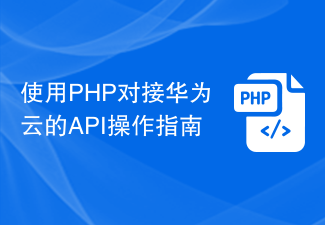 使用PHP对接华为云的API操作指南Jul 05, 2023 pm 06:13 PM
使用PHP对接华为云的API操作指南Jul 05, 2023 pm 06:13 PM使用PHP对接华为云的API操作指南华为云提供了丰富的API接口,使开发人员能够方便地使用华为云的功能和服务。本文将介绍如何使用PHP对接华为云的API,并附带代码示例。一、准备工作1.注册华为云账号并创建相应的应用程序,获取API密钥。API密钥包括AccessKey和SecretKey,用于身份验证和访问控制。2.确保服务器已经安装了PHP和相应的扩
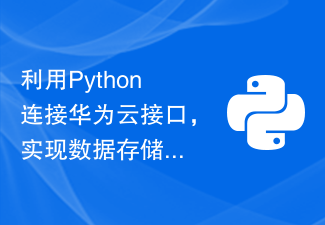 利用Python连接华为云接口,实现数据存储与检索Jul 05, 2023 pm 01:37 PM
利用Python连接华为云接口,实现数据存储与检索Jul 05, 2023 pm 01:37 PM利用Python连接华为云接口,实现数据存储与检索华为云是华为公司提供的一种灵活可扩展的云计算服务平台,提供了大量的API接口,方便开发者进行数据存储与检索。本文将介绍如何使用Python连接华为云接口,实现数据存储和检索的功能。首先,我们需要在华为云官网上注册并创建一个账号。然后,我们需要在华为云控制台中创建一个存储桶,用于存储我们的数据。接下来,我们需要
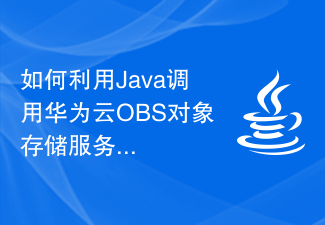 如何利用Java调用华为云OBS对象存储服务实现图片下载Jul 08, 2023 am 10:09 AM
如何利用Java调用华为云OBS对象存储服务实现图片下载Jul 08, 2023 am 10:09 AM如何利用Java调用华为云OBS对象存储服务实现图片下载引言:华为云OBS(ObjectStorageService)是一种安全可靠、高扩展性和低成本的云存储服务。它提供了灵活的存储解决方案,可以在各种场景下存储和获取大量非结构化的数据,如图片、视频、文档等。本文将介绍如何使用Java编程语言调用华为云OBS对象存储服务,实现图片下载功能。步骤1:华为云
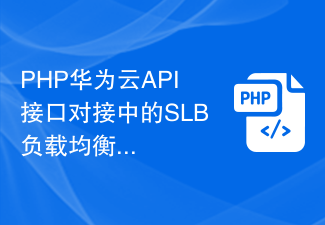 PHP华为云API接口对接中的SLB负载均衡与CDN加速配置示例Jul 05, 2023 am 08:22 AM
PHP华为云API接口对接中的SLB负载均衡与CDN加速配置示例Jul 05, 2023 am 08:22 AMPHP华为云API接口对接中的SLB负载均衡与CDN加速配置示例在进行PHP华为云API接口对接时,常常需要考虑到负载均衡和CDN加速的配置。本文将给出一个示例,介绍如何使用PHP代码配置SLB负载均衡和CDN加速。一、SLB负载均衡配置示例SLB(ServerLoadBalancer)是华为云提供的一种高可用的负载均衡服务。它通过将来自用户请求转发到多
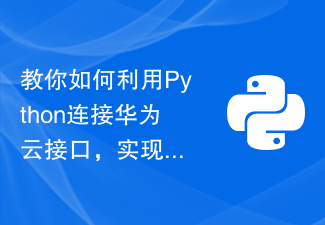 教你如何利用Python连接华为云接口,实现视频存储功能Jul 06, 2023 pm 06:49 PM
教你如何利用Python连接华为云接口,实现视频存储功能Jul 06, 2023 pm 06:49 PM教你如何利用Python连接华为云接口,实现视频存储功能华为云是一家提供云计算服务的知名公司,它提供了丰富的云服务和API接口,让开发者可以快速构建各种应用。在本篇文章中,我将教你如何利用Python编程语言连接华为云接口,实现视频存储功能。首先,我们需要在华为云上创建一个对象存储(OBS)桶,用于存储视频文件。在华为云控制台上,选择对象存储服务,点击"创建
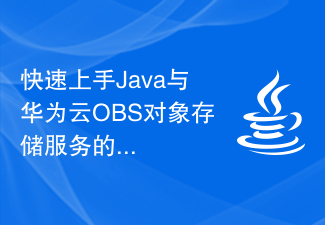 快速上手Java与华为云OBS对象存储服务的实践指南Jul 05, 2023 pm 12:58 PM
快速上手Java与华为云OBS对象存储服务的实践指南Jul 05, 2023 pm 12:58 PM快速上手Java与华为云OBS对象存储服务的实践指南引言:随着云计算的迅猛发展,越来越多的企业和个人都开始将数据存储到云端,以提高数据的可靠性和可用性。华为云的OBS对象存储服务就是一种功能强大的云存储解决方案。本文将介绍如何使用Java编程语言,快速上手华为云的OBS对象存储服务,并提供相应的代码示例供读者参考。一、准备工作注册华为云账号,并完成实名认证创
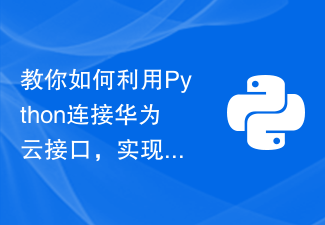 教你如何利用Python连接华为云接口,实现音频转写与合成功能Jul 06, 2023 pm 02:13 PM
教你如何利用Python连接华为云接口,实现音频转写与合成功能Jul 06, 2023 pm 02:13 PM教你如何利用Python连接华为云接口,实现音频转写与合成功能引言:随着人工智能技术的发展,语音合成和语音识别已经成为了很多应用领域中必备的功能。而作为一个开发者,我们可以利用Python语言连接华为云接口,实现音频转写与合成功能。本文将会介绍如何使用Python连接华为云接口,实现音频文件的转写和语音合成功能。一、注册华为云账号要使用华为云的语音服务,首先
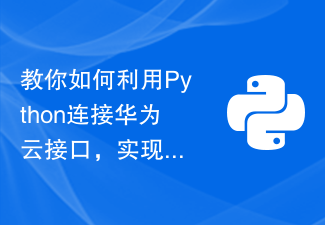 教你如何利用Python连接华为云接口,实现音频转码与存储Jul 05, 2023 pm 04:13 PM
教你如何利用Python连接华为云接口,实现音频转码与存储Jul 05, 2023 pm 04:13 PM教你如何利用Python连接华为云接口,实现音频转码与存储华为云是华为推出的一套云计算服务平台,旨在为用户提供稳定、安全、高性能的云计算服务。在华为云平台上,我们可以通过API接口实现各种功能,例如音频转码与存储。本文将为大家介绍如何利用Python连接华为云接口,实现音频转码与存储的功能。准备工作首先,我们需要安装Python的华为云SDK,可以通过pip


Hot AI Tools

Undresser.AI Undress
AI-powered app for creating realistic nude photos

AI Clothes Remover
Online AI tool for removing clothes from photos.

Undress AI Tool
Undress images for free

Clothoff.io
AI clothes remover

AI Hentai Generator
Generate AI Hentai for free.

Hot Article

Hot Tools

Dreamweaver CS6
Visual web development tools

DVWA
Damn Vulnerable Web App (DVWA) is a PHP/MySQL web application that is very vulnerable. Its main goals are to be an aid for security professionals to test their skills and tools in a legal environment, to help web developers better understand the process of securing web applications, and to help teachers/students teach/learn in a classroom environment Web application security. The goal of DVWA is to practice some of the most common web vulnerabilities through a simple and straightforward interface, with varying degrees of difficulty. Please note that this software

WebStorm Mac version
Useful JavaScript development tools

Atom editor mac version download
The most popular open source editor

MinGW - Minimalist GNU for Windows
This project is in the process of being migrated to osdn.net/projects/mingw, you can continue to follow us there. MinGW: A native Windows port of the GNU Compiler Collection (GCC), freely distributable import libraries and header files for building native Windows applications; includes extensions to the MSVC runtime to support C99 functionality. All MinGW software can run on 64-bit Windows platforms.





